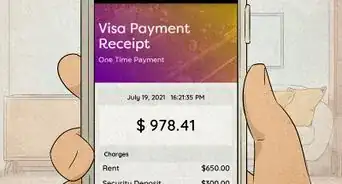This article was co-authored by Clinton M. Sandvick, JD, PhD. Clinton M. Sandvick worked as a civil litigator in California for over 7 years. He received his JD from the University of Wisconsin-Madison in 1998 and his PhD in American History from the University of Oregon in 2013.
This article has been viewed 483,830 times.
When renting an apartment, condominium, house, or office space, the landlord or property owner is usually responsible for the maintenance of the property. This maintenance may include making any major repairs, resolving dangerous conditions, improving the building or resolving any issues that his or her tenants may have with one another. If you need your landlord to resolve an issue or fix a problem, you should write a tenant complaint letter. Your complaint letter should reflect the specific problem that you need addressed, a time frame for completion, a request to fix the problem, and follow any state laws regarding demand and/or complaint letters.
Steps
Requesting Repairs
-
1Review the tenant laws in your state or country. Many places have very specific requirements on how a landlord must be notified about repairs or other conditions that are making your apartment or home unlivable. Before drafting a complaint letter, you should review the landlord-tenant laws for your area.
- You can review landlord tenant laws for your state at: http://www.nolo.com/legal-encyclopedia/state-landlord-tenant-laws
- For a guide to tenant rights in the U.K. visit: https://www.gov.uk/private-renting/your-rights-and-responsibilities
- For a guide to landlord and tenant rights in Germany visit: http://www.globalpropertyguide.com/Europe/Germany/Landlord-and-Tenant
- For a guide to tenant rights in Spain visit: http://www.idealspain.com/pages/information/Tenants.htm
-
2Review your lease. Your lease is the legal contract between you and your landlord. While laws may establish a landlord’s legal duties, a landlord or property owner may have assumed additional responsibilities in the lease. Carefully review your lease for any provisions on repairs and make sure that you follow any requirements for notifying the landlord in the letter.[1]Advertisement
-
3Use a professional letter format. When sending a request for repair letter, your letter should follow a business letter format. This conveys that you are serious about the request and puts the landlord on formal notice about the need for repairs.
- Your letter should be typed. If you do not have access to a computer and printer, you can hand print your letter.
- Your letter should be addressed to the person who is responsible for repairing your apartment. If both a live-in landlord and a property management company maintain the building, consider addressing the letter to the landlord and sending a copy to the property management company.
- Type the addressee’s full name and mailing address at the top left of the page. If you rent from an individual, this should be his or her name and address; if you rent from a company, this would be the name and business address of the property manager.
- Your letter should be dated, with the date placed above the address of the landlord or on the right side of the page as the first line of text.
- As discussed below, your letter should explain the problem that you are having and request the landlord’s assistance in correcting the problem.
- Provide your contact information, including phone number, address and email address so that the landlord can contact you to schedule any repairs.
- Sign the letter and type or print your name below your signature.
-
4Explain the problem and request assistance. A written request for repairs allows you to more fully explain the problem for which you are requesting assistance. Often, tenants have already orally requested a repair and the letter is a second, more formal request, for the landlord’s assistance. When drafting the letter, you should include the following:
- A clear and concise description of the problem should be included in the opening paragraph of the letter. Be as specific as you can in describing the problem. For example, instead of saying “I have a leak” say instead, “There is a slow leak in the plumbing under the kitchen sink.”
- Provide the date on which the problem began. If you are unsure of the exact date, provide the approximate date or the month in which you first noticed the problem(s) or began having the issue.
- If you previously requested that the landlord repair the problem, your letter should include the date(s) that you spoke to the landlord about the problem.
- If you are requesting a minor repair, it may be helpful if you explain how the minor problem could become worse. For example, if you are asking for the tile grout to be replaced because some of it is missing, you could state that you are concerned that water is getting behind the tile and may cause a serious mold condition.
- Highlighting how a problem could get worse or become dangerous may motivate a landlord to make minor repairs.
- Explain any steps that you have taken to resolve the problem, including if you obtained an opinion or estimate from a professional. If your received an estimate, you should attach it to your letter.
- In a new paragraph, you should request that the landlord fix or resolve the issues. You can request that the problem(s) be fixed by a certain date, and if necessary, describe how you would like the issue resolved. You can also offer your assistance in fixing the problem.[2]
-
5Make a copy of the letter. You should make a copy of the letter for your records. If the landlord refuses to make the repairs, you may need the letter to present as evidence in small claims or housing court.
-
6Send the letter. While it may be easier to send the letter via email, if you have previously requested assistance and your landlord has failed to rectify the problem, you should send the letter by certified mail. You can also send the letter via email or facsimile but this should be in addition to a hardcopy letter being sent.
- A hardcopy letter should be sent via certified mail. This will allow you to document that the letter was delivered to the landlord.
- You may begin checking the United States Post Office (“USPS”) website for delivery confirmation approximately 2-3 days after mailing a letter by certified mail. You can find the USPS’s track and confirm utility on its website at https://tools.usps.com/go/TrackConfirmAction_input. Once you receive confirmation of delivery, print it, and staple it to your copy of the letter.
- If you have corresponded with the addressee via e-mail in the past, you may choose to deliver your complaint letter as an attachment to an e-mail, in addition to hardcopy. When delivering a legal letter via e-mail, request a delivery receipt. Check your e-mail reader’s documentation for instructions on how to do this using your specific e-mail software.
- Once you receive confirmation of e-mail delivery, print it and staple it to your hardcopy of the letter.
- Sending a letter by fax is appropriate in most cases where the recipient commonly uses a fax for business purposes. If you rent from a company or individual that maintains office hours, you may choose to send your letter via fax to the business’s fax number.
- Most fax machines print a delivery confirmation page, which you should staple to your copy of the letter.
Failing to Return Security Deposit
-
1Make sure that you comply with lease. Most leases outline the reasons why a landlord can keep your security deposit. Before vacating an apartment, make sure that you satisfy all requirements under the lease so that the landlord cannot justifiably keep your deposit. Some justifications a landlord may use to keep your deposit include:
- Failure to pay rent.
- Failure to leave the apartment in a clean condition.
- Failure to make minor repairs.
- Failure to give appropriate notice of vacating the apartment.
- Failure to return keys.
- Failure to remove trash or all personal belongings.[3]
-
2Request a walkthrough. Before leaving your apartment, you can request that the landlord walkthrough the apartment with you and note any issues that need to be remedied before you leave. If you have significantly damaged the apartment, you may be required to repair the property. However, you are not responsible for normal wear and tear on the apartment that occurs from reasonable use of the space.
- By requesting a walkthrough, you are putting the responsibility on the landlord to note any issues before you leave so he or she can not use them as a justification for failing to return your security deposit later.[4]
-
3Document your vacated apartment. After you have cleaned the apartment and removed all of your belongings, you should photograph the condition in which you left the apartment. By having documentation, a landlord cannot justifiably claim that you left the apartment in a condition that violated the lease.[5]
-
4Review your state’s laws. Most states have laws that detail the timeframe a landlord has for returning your security deposit. You can review state laws at: http://www.nolo.com/legal-encyclopedia/security-deposit-limits-deadlines-your-state-36186.html.
- Make sure that you give your landlord your forwarding address so that he or she can return your deposit to you.[6]
-
5Draft a letter requesting your deposit. If your landlord fails to return all or some of your deposit within the timeframe set forth by your state’s law, you should draft a letter requesting the return of your deposit. Your letter should include the following:
- A detailed description of the condition that you left the apartment and why you are entitled to receive your deposit back.
- If the landlord kept a portion of your deposit and you dispute his or her reasoning, you should explain why the landlord wasn’t justified in keeping any of your deposit. You can send a copy of the pictures of the apartment as evidence of the condition of the apartment when you vacated it.
- Cite your state’s laws regarding the return of the security deposit and explain that the landlord is violating the law.
- Explain that you will take the landlord to small claims court unless the matter is resolved.
- Send the letter certified mail via the United States Postal Service.[7]
Notifying Landlord of Dangerous Conditions
-
1Recognize a dangerous condition. Generally, landlords are legally responsible for correcting dangerous conditions in your rental space or the apartment building. Dangerous conditions may include:
- Structural problems, such as damaged walls or roof.
- Failing to provide working locks on windows and doors.
- Failing to provide smoke and carbon monoxide detectors.
- Unsafe or unsanitary stairways.
- Damaged electrical or plumbing services.
- Failing to rectify rodent or pest infestations.
- Failing to evict drug sellers living in the building.[8]
-
2Notify landlord of the condition. Your landlord may not be aware of the dangerous condition on the property and therefore you must send the landlord a letter notifying him or her of the condition. Your letter should include:
- A detailed description of the hazard.
- If you previously notified the landlord of the condition, state when you gave prior notice.
- State that you have serious concerns for your personal safety.
- Describe the potential and foreseeable harm that could occur, such as fire or burglary.
- If you are concerned about a lack of security precautions such as workable locks or a gate over a window leading to a fire escape, you can note (if applicable) recent incidents of crime in your area.
- Request that that the situation be rectified immediately.
- Sign and date your letter.
- Send your letter via certified mail and keep a copy for your records.[9]
- You can view a sample notice letter at: http://www.nolo.com/legal-encyclopedia/sample-letter-alerting-landlord-dangerous-conditions.html.
-
3Rectify the situation. If your landlord fails to make the necessary repairs, you should take steps to minimize the potential harm. This can include:
- Having the problem fixed and deducting the cost from your rent.
- Breaking your lease.
- Withholding rent.
- You should review your state’s laws in order to act in accordance with any legal requirements. However, your first concern should be your personal safety.
Petitioning Landlord for Improvements
-
1Have a tenants’ meeting. If there are general improvements that need to be made to a rental building to make it more habitable, consider holding a tenants’ meeting to discuss the matter. At the meeting you should discuss the need for large-scale repairs, such as replacing all of the windows or a continually out of service elevator, and vote on the most important repairs needed in the building. By having a consensus, the tenants are in a much stronger bargaining position than if one tenant requested improvements.
-
2Create a petition. Once the demands have been agreed upon, one tenant should draft a petition that outlines the requests for specific improvements and contains signature pages for tenants to add their names and apartment numbers.
- The petition should be posted in a common area to maximize tenants reviewing and signing the document.
- The petition can also be circulated at tenants’ meetings or other gatherings.
- A person could also go door-to-door soliciting support from other tenants in the building.
-
3Draft a letter to the landlord. Once you have gathered a significant number of signatures, you should draft a letter to the landlord requesting the improvements. You should attach the petition and signatures of the tenants to the letter. In addition, the letter should include:
- A polite request for the landlord to make the improvements and/or repairs.
- A specific date by which the landlord should respond to the request.
- An explanation of why the tenants believe the repairs are necessary.
- If this is the first request for improvements, it may not be in the tenants’ best interest to threaten repercussions if the landlord fails to act. However, the letter should be firmly worded so that the landlord takes the request seriously.
- The letter should be sent via certified mail and a copy should be maintained by the tenants association or by the person spearheading the petition.[10]
- You can view a sample petition letter at: http://www.nolo.com/legal-encyclopedia/sample-group-petition-landlord-repairs-property-improvements.html.
Sample Letters
References
- ↑ http://www.nolo.com/legal-encyclopedia/renters-rights-minor-repairs-30276.html
- ↑ http://www.nolo.com/legal-encyclopedia/renters-rights-minor-repairs-30276.html
- ↑ http://www.nolo.com/legal-encyclopedia/get-security-deposit-back-29695.html; https://www.ag.ny.gov/sites/default/files/pdfs/publications/Tenants_Rights.pdf
- ↑ http://www.nolo.com/legal-encyclopedia/get-security-deposit-back-29695.html
- ↑ http://www.nolo.com/legal-encyclopedia/get-security-deposit-back-29695.html
- ↑ http://www.nolo.com/legal-encyclopedia/get-security-deposit-back-29695.html
- ↑ http://www.nolo.com/legal-encyclopedia/get-security-deposit-back-29695.html
- ↑ http://www.landlordtenantlawfirms.com/repairs-and-maintenance/landlord-liability-unsafe-living-conditions.htm
- ↑ http://www.nolo.com/legal-encyclopedia/sample-letter-alerting-landlord-dangerous-conditions.html
About This Article
If there’s a problem with your rented apartment, house, or office space, you may need to write a tenant complaint letter to get it resolved. It’s best to use a professional letter layout, which helps to convey the seriousness of the problem. Explain the problem as specifically as possible. For example, instead of saying “There’s a leak,” write something like, “There is a slow leak in the plumbing under the kitchen sink.” Tell them the date it started or when you first noticed it and any steps you took to try to fix the problem. If there’s a chance of the problem getting worse or more dangerous, mention this too, since this can help to motivate your landlord to fix it. You should also include your contact details at the bottom so they can easily get in touch to schedule repairs. For more tips from our Legal co-author, including how to petition your landlord to make improvements to your home or office, read on.


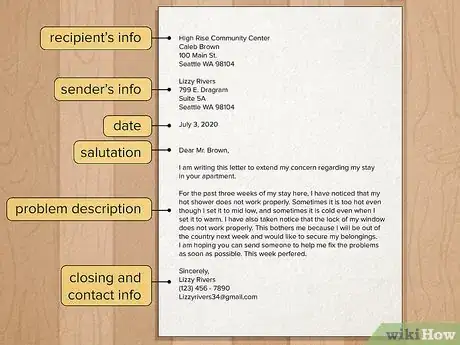
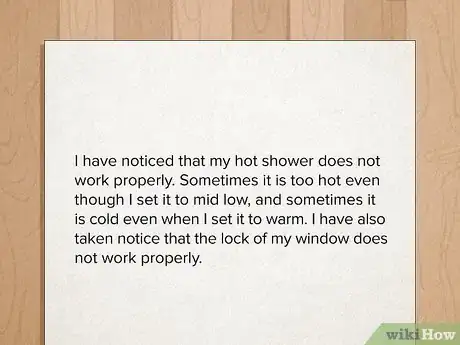
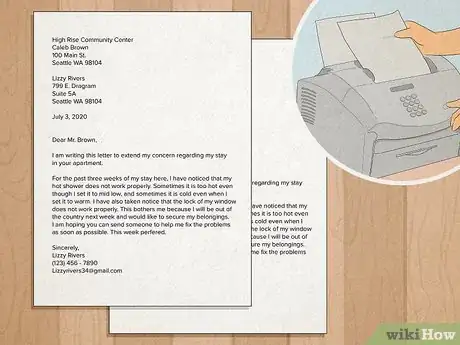
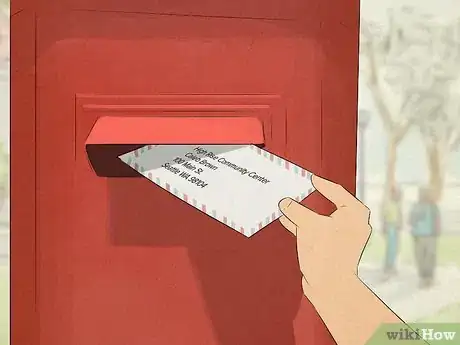


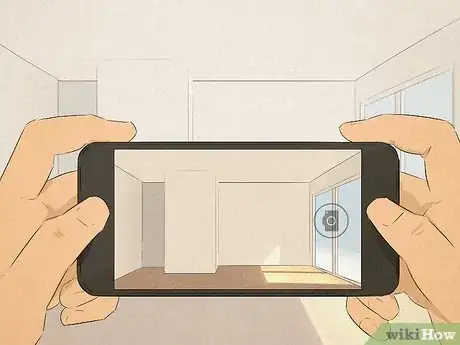
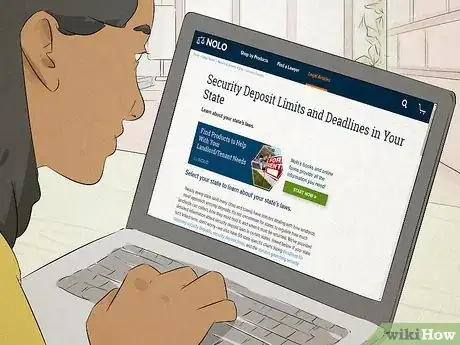
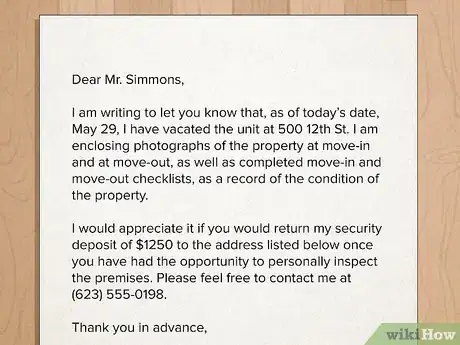

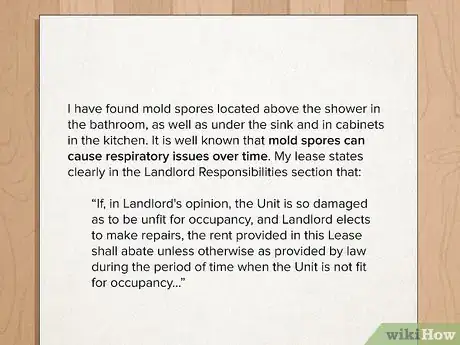


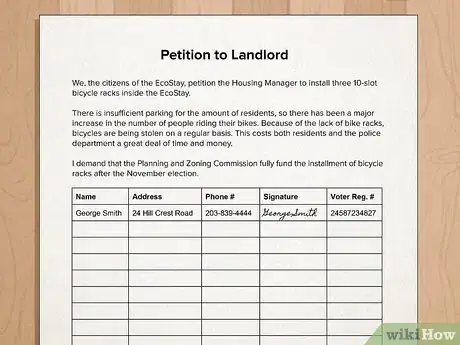

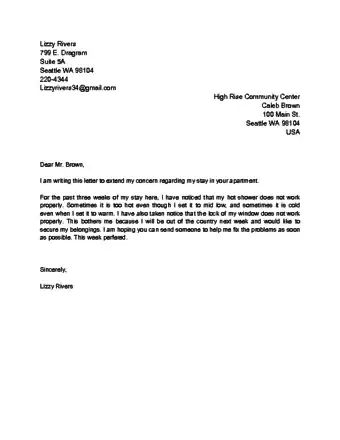
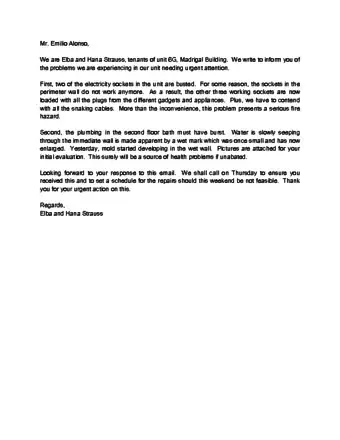
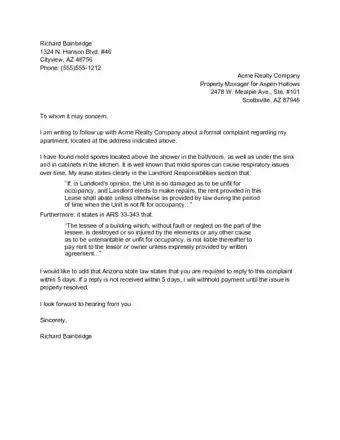
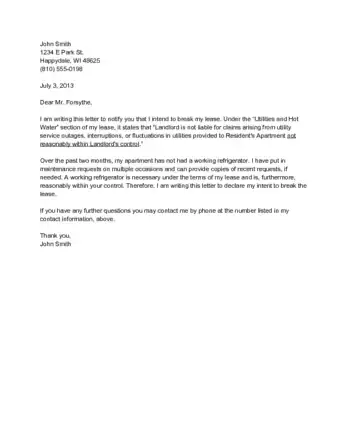
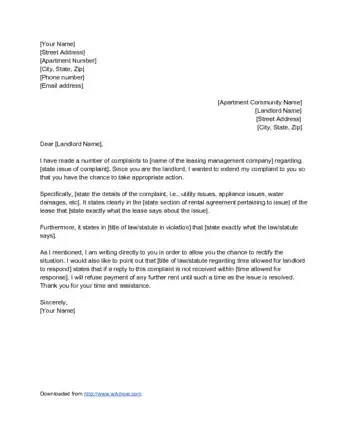





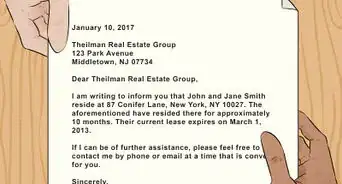



-Step-10.webp)


